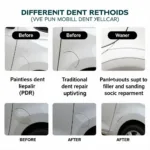Fixing paint chips on your car is a common DIY project that can save you money and maintain your car’s appearance. Whether it’s a small rock chip or a larger scratch, addressing these imperfections early can prevent rust and further damage. This comprehensive guide will provide step-by-step instructions on how to repair paint chips on your car effectively, just like an instructable, covering everything from assessing the damage to achieving a professional-looking finish.
Assessing the Damage and Gathering Your Supplies
Before diving into the repair process, it’s crucial to assess the extent of the damage. Minor chips, affecting only the clear coat or top layer of paint, are easily fixable with touch-up paint. Deeper chips that expose the primer or bare metal require more attention and might involve sanding, priming, and even some body filler.
Once you’ve determined the severity of the chip, gather the necessary supplies. For minor chips, you’ll need touch-up paint, rubbing compound, polishing compound, and applicator pads. For deeper chips, add primer, sandpaper (various grits), body filler, and a plastic spreader to your list. Always ensure your chosen products are compatible with your car’s paint type.
Step-by-Step Guide to Repairing Minor Paint Chips
For minor chips, the process is straightforward. First, clean the area around the chip thoroughly with soap and water, then dry it completely. Next, apply a small amount of touch-up paint directly to the chip, ensuring it fills the cavity without overflowing. Let it dry completely, then use fine-grit sandpaper to carefully level the touch-up paint with the surrounding surface. Finally, apply rubbing compound followed by polishing compound to blend the repair and restore the shine.
Repairing Deeper Paint Chips: A More Involved Process
Deeper chips require a more extensive approach. Start by cleaning and sanding the chipped area to remove any loose paint or rust. If the metal is exposed, apply a thin layer of primer to prevent further corrosion. Once the primer dries, apply body filler if necessary, shaping it to match the surrounding contours. After the filler hardens, sand it smooth, then prime the entire repaired area. Finally, apply several thin coats of touch-up paint, allowing each coat to dry before applying the next. Finish with rubbing and polishing compound for a seamless blend.
Preventing Future Paint Chips: Protective Measures
Preventing paint chips is always better than repairing them. Consider applying paint protection film to vulnerable areas like the hood, bumper, and mirrors. Regularly waxing your car also adds a layer of protection against minor scratches and chips. Avoid tailgating, especially on gravel roads, and be mindful of low-hanging branches or obstacles that could scratch your car’s paint.
Conclusion
Repairing paint chips on your car is a manageable DIY project that can save you money and keep your vehicle looking its best. By following these how to repair paint chips on car instructables, you can address both minor and more significant chips effectively, preventing rust and maintaining your car’s value. Remember to assess the damage carefully, gather the right supplies, and follow the appropriate steps for a professional-looking result.
FAQ
- What type of touch-up paint should I use?
- How long should I wait for the touch-up paint to dry?
- Can I repair paint chips in direct sunlight?
- What if the chip is larger than a dime?
- How can I prevent future paint chips?
- What is the best way to match the touch-up paint to my car’s color?
- Can I use nail polish to repair a paint chip temporarily?
Need help with car repair? Contact us via WhatsApp: +1(641)206-8880, Email: [email protected]. We have a 24/7 customer support team.


